|
|
Flageolet

|
|
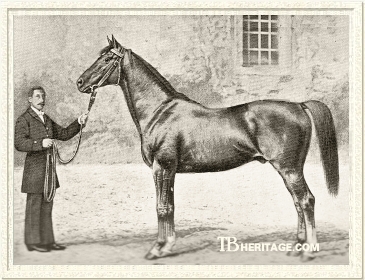 |
|
|
Flageolet, a handsome, chestnut stayer with a turn of speed, was the first French-bred and owned stallion to head the sires list in England, was twice leading sire in France, and in Germany was influential in the development of various warmblood breeds through his sons. He got LE DESTRIER, a leading sire in France, and the tough, game RAYON D'OR, a leading sire in the U.S. Although he was the sire of a number of classic winning sons in both France and Germany, his tail-male line did not persist beyond a couple of generations. It is through his daughters, and those of his sons, that he is seen in thoroughbred pedigrees today.
His sire, Plutus (1863), was out of a Planet mare and by the handsome chestnut Trumpeter, the latter a winner of two of his three starts as a juvenile and third in the Epsom Derby (to Musjid), in which he ran lame, and afterwards was retired from the turf. Trumpeter was a successful stallion that got mostly precocious juveniles and milers.
Plutus was bred by Charles Harbourd, 5th Baron Suffield, an intimate of the Prince of Wales (Edward VII) who served in various high court positions. He had a seat at Gunton House, Norfolk, and his grandfather, William, the 2nd Baron, had been active in racing, owning Muley and Leviathan at different times. Plutus's unnamed dam was by Planet. Planet (by the great runner Bay Middleton), who had "iffy" legs, had been a good juvenile winner owned by Lord George Bentinck, taking Goodwood's Molecomb Stakes, the Glasgow Stakes, and second in Doncaster's Champagne Stakes;. He was one of the horses purchased en-masse by Edward Mostyn when Bentinck suddenly sold his entire stud and racing stable in one complete lot. The Planet mare, later called Brittania, bred four foals in England for Suffield before she was purchased by Count Fréderíc de Lagrange in 1863 and sent to France. Plutus, her last born in England, was sold as a yearling to Auguste, the Duc de Morny, and remained in England to race. Morny died in 1865, and Plutus was purchased by count Frédéric de Lagrange.
Plutus was at best a mediocre runner. At age three he ran fourteen times, and won twice. While tried up to two miles (Chester Gold Cup, unplaced), he was best under a mile. His two wins were a handicap sweepstakes at Newmarket First Spring over the Two-Year-Old course, beating four by 1-1/2 lengths, and the Great Eastern Railway Handicap (Two-Year-Old course) at Newmarket First October by a neck, beating fifteen others, receiving weight from about half the field. Other than those wins, he placed second to Colsterdale in Chester's Steward's Cup (1 mile-7 furlongs), with only three running; third in Goodwood's Steward's Cup (Two-Year-Old course) to Sultan, with 23 in the field; a dead-heat for third with Dalesman in the Newmarket First October Handicap Sweepstakes (Two-Year-Old course). Generally speaking, the longer the race, the further back in the field he placed. At the end of the season he was sold to Charles Laffitte for 41,000 francs, and went to France.
In France Plutus proved to be a good stallion; his offspring, unsurprisingly, tended to be precocious and speedy. Among his winners were Gournay (1884) a winner of the Prix du Nabob; Fricandeau (1883), who took the Prix d'Orange and Prix de la Forêt, and Newmarket's Criterion Stakes winner Monsieur Phillippe (1876). He got many good broodmare daughters, including Cambuse, dam of Cambyse, the leading sire in France in 1898; Ismenie, dam of Acheron (prix des Sablons, Prix de la Forêt), Cerbere (Prix Greffulhe), and Phlegethon (Poule d'Essai des Poulains); Optima, dam of Prix Royal Oak and Prix du Cadran winner Ivoire; Aurore, dam of Prix du Nabob winner Achille; Clarinette, who produced Chapeau Chinois, another Prix du Nabob winner, and Lamballe, dam of Prix de la Forêt winner Limousin. Plutus' best runner was Flageolet, who, along with Cambuse, is largely responsible for Plutus' presence in pedigrees.
Flageolet's dam, La Favorite (1863, by Monarque) was out of Constance, by Gladiator, one of the mares in the partnership de Lagrange had with Pol Nanquette called Le Grande Ecurie. Constance was an excellent broodmare that produced Fidélité (1861), a winner of the Prix Jouvence and second in the Grand Prix de l'Empereur (Prix Gladiator, 6,200 meters), later dam of successful winners; L'Aventuriere, tail-female ancestress of many good winners; Le Sarrazin (1865), a winner of Epsom's Woodcote Stakes, the Prix du Cadran, Prix des Pavillons, and Prix de l'Empereur, later a useful stallion. La Favorite won five races at age three, including the Grand Prix de Bourgogne at Chalon-sur-saône and the Prix de Chantilly. While Flageolet's sire's side was mostly speed for a couple of generations, his dam's line featured horses that won at classic distances and beyond. Flageolet inherited both the speed and the ability to stay.
Flageolet was bred by Claude-Joachim Lefèvre, who had leased de Lagrange's Haras Dangu and most of its bloodstock, including La Favorite, for several years. In 1870 she dropped Flageolet to the cover of Plutus. Flageolet was a handsome chestnut, by most accounts "very beautiful," although an English writer said he had "...a dipped back and slight plainess about the head and neck," that still "...did not detract from his quality, there could be found no weak spot in the flat, steely legs, with arms and thighs prodigal of muscle, and a bright, burnished coat." He did inherit large, flat feet and low heels from his dam, a typical feature of Monarque offspring, but like her, he was not affected by any foot problems. Although he himself was called sweet-tempered, he did get some temperamental offspring, notably LE DESTRIER and COMTE ALFRED. In France Flageolet was trained by Arthur Carter at Royal-Lieu, near Paris, and in England by Tom Jennings at Newmarket's Phantom House.
Flageolet on the Turf
Flageolet debuted in the Prix des Deux Ans (Prix Morny) at Deauville in July, and won, beating six. Lefèvre then sent him to England to race in the fall. He ran seven times, winning five. He took the Hopeful Stakes, beating five, at Newmarket Houghton, and carrying the heaviest weight, and at Newmarket First October won the Rutland Stakes, beating three, and the Forlorn Stakes (beating one). At Newmarket 2nd October he ran three times: he won the Burwell Stakes beating the fine German filly Amalie von Edelreich. He was third in the Middle Park Plate, won by Surinam and Kaiser in a dead-heat, and was beaten by a head by Surinam in the Prendergast Stakes (eighteen ran), but ended the season by taking the big juvenile race, Newmarket's Criterion Stakes, beating six other youngsters.
At age three he just could not beat his French-bred generational rival, Henri Delamarre's Boïard, placing second to him in both the Prix du Jockey Club and the Grand Prix de Paris. He was also second in the Prix du Cédre (1 mile-3 furlongs), at Paris, beaten by the more lightly-weighted Apollon by a length, with Montargis third. In England, he ran unplaced to Gang Forward in the Two Thousand Guineas, with ten in the field. At Ascot, he ran second to the year-older Cremorne in the Ascot Gold Cup (2-1/2 miles), beaten by eight lengths, with six others in the field. In August he won the Goodwood Cup by 30 lengths, beating Epsom Derby winner Favonius and Cremorne. He was second to Uhlan, age four, by a neck in the Brighton Cup with three others in the field. In October he took the Grand Duke Michael Stakes (beating four, including Doncaster) at Newmarket First October and at Newmarket Houghton won the October Free Handicap (10 furlongs), and followed that by taking the first running of the Jockey Club Cup at Newmarket (2-1/4 miles) in a canter, beating six. He had shown himself to be a consistent, speedy stayer of the first-order, if not quite as good as those two cracks, Boïard and Cremorne.
The next season, age four, he won Newmarket's Claret Stakes (two miles). At Ascot he came up against Boïard again, and once again, could not beat that grand runner, dead-heating with Doncaster for second place, and the next day was a bad third to King Lud and Boïard in the Queen Alexandra Plate. Back in France in the fall, he was second again to Boïard in the Prix du Cadran, and in the Prix Rainbow.
Flageolet in the Stud
Flageolet was retired to Lefèvre's Haras du Chamant at the end of 1874. In one of the many intricate relationships practiced by many French breeders and owners, Lefèvre had a partnership with de Lagrange, in which he sold the count all the Chamant yearlings for 200 sovereigns each, with the exception of the "more moderate ones," which were left at Chamant. The count raced the horses, with the winnings divided with Lefèvre. When the youngsters retired from the turf or at age five, they returned to Chamant as breeding stock; it is not clear what the division was when a horse was sold from Chamant to another breeder. Thus many Chamant products ran in Lagrange's name, although they were at least partially owned by Lefèvre, at least in England, where the partnership had great success with the offspring of Lefèvre's grand stayer, Mortemer, in the 1870s.
By the end of the decade Flageolet had superceded Mortemer as the star of the Chamant stud. He took first prize for stallions at the Exposition Universelle Chevaline in Paris in 1878 (Mortemer was third). More importantly, his son, RAYON D'OR, catapulted him to the top of the leading sires list in Great Britain -- the first French-bred and based stallion to reach those heights -- in 1879, and in that year, and following year his youngsters put him at the top of the French sires list. Several of his sons in France were purchased by the Haras Nationaux to improve cavalry and riding horses, and some had an influence on steeplechasing in France. His son ZUT was one of the two sires listed for Le Torpilleur, and son MANOEL was the sire of Melibee, both of them winners of the Grand Steeple-chase de Paris and other jump races. His son LE DESTRIER was a leading sire in France in 1888, and son BEAUMINET became a good stallion in Hungary. His best sire son, however, was RAYON D'OR, who became a leading sire in the U.S.
In 1885 Flageolet was purchased by Georg von Lehndorff, general manager of the Prussian state studs, who had been visiting France and England for years, buying stallions and mares to improve German bloodstock. Flageolet was installed at the state stud at Graditz. There he got some good runners, including German Derby winner (dead heat) GEIER (1890), Henckel-Rennen winner ARGWOHN, and two winners of the Preis der Diana. Most Flageolet sons were used at various state stud depots as improvement sires on half-bred mares, and some sons and daughters are seen in Trakehner and other warmblood pedigrees, notably Hanoverian and Westphalian show jumpers (from the Gotthard, Grande and Grannus sire lines) descended from Goldfisch II (1935), a descendant of Flageolet's son, GOLDSCHAUM (1891).
In France
|
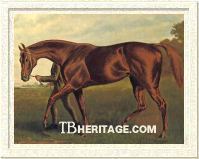
Rayon d'Or
| |
RAYON D'OR (1876) was out of the superior broodmare Araucaria (1862, out of the great Pocahontas and by Ambrose), who had been purchased in foal to Macaroni by Lefèvre in 1872. Her 1873 filly was Camélia, who would later win Newmarket's One Thousand Guineas and dead-heat for first in the Epsom Oaks. The next year she produced the English Two Thousand Guineas winner Chamant (by Mortemer), later six times leading sire in Germany. In 1876 she dropped RAYON D'OR, and after that produced Apremont, who became a leading sire in New Zealand. RAYON D'OR was a big colt, close to 17 hands, with a slightly ewed neck and powerful shoulders.
|
RAYON D'OR was one of two really good Flageolet colts born in 1876, each of which were champions at age three, one in England and one in France. He was precocious, speedy, and could stay. He ran in England in count Fréderíc de Lagrange's colors as a juvenile, winning four of his five races, among them Goodwood's Lavant Stakes and Doncaster's Clearwell Stakes. At age three, although only third in the Two Thousand Guineas and unplaced in the Epsom Derby, he came on strong in the second half of the season, taking Ascot's St. James's Palace Stakes, Newmarket's Great Foal Stakes (1-1/4 miles) and Champion Stakes (1-1/4 miles), a free handicap sweepstakes at Newmarket, Goodwood's Sussex Stakes, Doncaster's Zetland Stakes (walk-over), and the Doncaster St. Leger (by five lengths, never headed). His wins were responsible for putting Flageolet at the top of the leading sires list in Great Britain in 1879, and making de Lagrange the leading owner in Great Britain. At age four he ran in France, winning the Prix du Cadran and the Prix Rainbow (5,000 meters), both in a canter, in the latter beating his crop-mate and champion French runner ZUT, and in England his wins included the Rous Memorial Stakes and a walk-over for Newmarket's Prince of Wales's Stakes.
RAYON D'OR retired to Lagrange's Haras Dangu, but only covered a few mares before the stud was dispersed in 1882, when he was purchased by American coal baron William Scott and shipped to Scott's Algeria Stud at Eire, Pennsylvania; in 1892 he was bought by August Belmont and spent his remaining four years at Belmont's Nursery Stud. He was frequently among the leading sires in the U.S., and topped the list in 1889. His get ran the gamut, from precocious juveniles to weight-carrying stayers, and included the outstanding Tenny (1886), a winner of 25 of his 65 races; the sturdy, gelded Banquet; the champion juvenile Chaos (1887); the good three-year-old Octagon (1894, Withers Stakes, Brooklyn Derby, etc.); champion three-year-old filly Souffle (1893) and the high-class filly Gypsy Queen, among many others. While some of his sons got good winners, it was his high-class broodmare daughters that sent his bloodlines forward, often through their useful sire sons.
ZUT, the top of his generation at age three in France, was another member of Flageolet's 1876 crop. a "very lengthy" horse with "plenty of bone and muscle," he was out of the flashy chestnut Epsom Oaks winner Regalia, who had been purchased by de Lagrange, and was an extremely productive broodmare at Haras du Chamant. She was the dam of Mortemer's grand staying son, Verneuil (1874, Ascot Gold Cup, etc.) and his sister Clementine (1875), a winner of the Poule de Essai des Pouliches and other good races, as well as Grand National Steeplechase winner Regal (1871), Lina (1873), the dam of Prix de Diane winner Annita (1889, by The Bard), and several sisters to ZUT that bred on, as well as two daughters by Flageolet's grandsire, Trumpeter, that also established long-lived families. ZUT's brother, RÉUSSI (1879) ran in England unsuccessfully, but became an important sire in Anglo-Arabian breeding in France.
Running in de Lagrange's name, ZUT, who had run in England as a juvenile, dead-heating with Lancastrian for a sweepstakes at Newmarket Cotober (he ran out of steam in the Crtierion), debuted at age three in the Prix du Nabob, which he won, beating Venise and Saltèador. In England he won a sweepstakes at Newmarket Craven, but ran unplaced in the Two Thousand Guineas. He then won the Poule d'Essai des Poulains at Longchamp, beating ISMAEL and Avermes and then took the Prix du Jockey Club by two lengths, beating Commandant and Flavio. Shipped to England, he did not place in the Epsom Derby, and was returned to France to run in the Grand Prix de Paris, where he was fourth behind the grand filly Nubienne, Saltèador and Flavio. Back in England he was uplaced in the Ascot Derby, but at Goodwood won the Racing Stakes. In the fall he won the Prix Royal Oak, beating Saltèador and Prologue. In England he did not place in the Doncaster St. Leger, or Newmarket's Select Stakes, and in October ran third to Westbourne and Lancastrian in the Newmarket Derby. The next year, 1880, the best he could do was third to Isonomy and Chippendale in the Ascot Gold Cup in England and second to RAYON D'OR in the Prix Rainbow at Longchamp.
ZUT was a moderately successful sire; his best was probably Frapotel (1884, from Mlle. de Fligny by Bois Roussel), who won all three of his juvenile races -- the Prix de Villiers, the Prix de Deux Ans, and the Grand Criterium (beating Le Sancy by half a length). Frapotel's brother, Fligny (1886) took Le Coupe at Longchamp at age three. Another ZUT son, Canigou (1891, out of Isolina by Specululm) took the Prix Biennal at Longchamp at age four, and Palamede (1882, from Palmyre, by Vermout) won the Prix Greffulhe for Henri Delamarre at age three. His daughter, Fee Printemps (1895, out of Feroza, by Hermit) took Longchamp's Prix Vanteaux at age three. Pomard (1890, from Plaintive, by Don Carlos) won the Prix Rainbow at age five. ZUT was the first cover, and Eusebe the second, on the dam of the grand French 'chaser Le Torpilleur, a winner of the Grand Steeple-chase de Paris in 1889.
ZUT'S daughters were the dams of some winners. Germaine II (out of Galantine, by Pompier) produced Germain (1896, by Stracchino), a winner of the Prix Biennal (now Prix Jean Prat). Illusion (1886, from Ironie by Trocadero) was the dam of Reine des Fleurs (1898 by Bruce), a winner of Ascot's Golden Jubilee (All-Aged) Stakes in England. Closerie (1888, from Clotho, by Bois Roussel) bred Turenne (1901), a winner of the Prix Kergolay and the Prix de Deauville at age three. Alice (1889, out of Genius, by Muscovite) was the dam of Love Grass, a winner of the Prix du Chenes at age two, and second in the Grand Prix de Paris at age three. Orange et Bleu (1887, from Orpheline by Fitz-Gladiator) produced Ortie Blanche (1894, by Ranes), a winner of the Prix Vermeille at age three. A number of his daughters bred on.
Another good Flageolet son, BEAUMINET (1877, out of Beauty, by Knowsley) ran for Lefèvre. He went to England to run in the Two Thousand Guineas, where he placed fourth -- the French sporting press suggested he had placed better and was deliberately unplaced by the English judges of the race. In France he took the Grande Poule des Produits at Longchamp, and then won the Prix du Jockey Club, with the famous English jockey Fred Archer up. He failed to place in the Grand Prix de Paris, but in the fall took the Prix Royal Oak at Longchamp. The next year, 1881, he dead-heated with LE DESTRIER in Longchamp's Prix Biennal, and ran second to Milan in the Prix du Cadran.
BEAUMINET was sold to the Hungarian state stud at Kisbér, where he got some high-class winners. Before he left, however, he got Chalet (1887, from The Frisky Matron, by Cremorne). Chalet ran for the Comte Le Marois, and at age three took four races, including the Prix de la Forêt, and at four his wins included Chantilly's Prix d'Hedouville. In France, Chalet managed to continue the sire line by getting Maximum (1899, from Urgence, by Dollar), a truly good stayer. Maximum was bought at the Haras de Lonray yearling sales for 19,000 francs. Racing for Jacques de Brémond, he won the Prix Greffuhle, Prix Hocquart, Prix Kergolay and Grand Prix de Deauville, and the Prix de Chantilly in 1902, the Ascot Gold Cup and Prix Rainbow in 1903, and the Prix Gladiateur in 1905. Maximum got some winners, including Pere Marquette, a winner of the Prix Hocquart, and the steeplechaser Ultimatum, a winner of the Grand Steeple-Chase de Paris; he was also dam's sire of the stayer Keror, winner of the 1922 Prix Royal Oak and Prix Kergolay.
In Hungary, BEAUMINET'S winners included Bonvivant (1896, from Polyolbion by Sir Bevys), that ran for Baron H. Königswarter. Bonvivant was third in Deutsches Derby, but took the more prestigious Austria Trial Stakes, and the following year won the Graf Hugo-Henckel. BEAUMINET'S daughter, Per Pedes (1894, from Peeress, by Doncaster) won the Magyar Kanca dij at three, and the Österreichisches Stutenpreis at age four, and later produced Peregrin (1905), a top juvenile runner in Hungary that at age three won the Millenniumi Dij and other good races. Other BEAUMINET winners in Hungary included Barnato (1896, Zent Laszlo dij), Szelvesz (Austria Preis), and Loindelle (Österreichisches Stutenpreis).
BEAUMINET'S generational rival was the extremely temperamental LE DESTRIER (1877, out of La Dheune, by Black Eyes). LE DESTRIER had been purchased as a juvenile from Haras du Chamant by the partnership of Paul A. Staub and Pierre Donon, and despite his abilities, proved an erratic runner. LE DESTRIER'S dam, La Dheune, was a local heroine -- during the brief German occupation of France in the Franco-Prussian war of 1870, German cavalry officers went scrounging for equine booty. One came upon La Dheune, a barely-broken two-year-old apparently as testy as her son would prove to be, and determined to ride off on her. She threw him several times, and in a fit of pique, he struck her in the knees with his sword several times, after which she staggered off. She was retrieved shortly thereafter, and carefully nursed back to health by the appreciative stud's staff. Her female line, alas, persisted for only a couple of more generations.
|
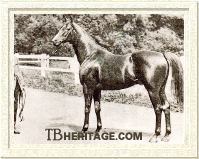
Le Destrier
| |
LE DESTRIER won La Bourse, and then ran in several minor races without winning until the Poule d'Essai des Poulains, which he took easily. He was a big favorite for the Prix Daru, and failed to place. In the Prix d'Apremont he beat La Jonchére and Castillon. In the Grand Prix de Paris he ran second to the British horse, Robert the Devil. He ran second to Milan, who he had beaten in the Grand Prix de Paris, in the Prix de Seine-et-Marne. At Deauville he was second to the inferior Poulet in the Prix Spécial, but followed that by taking the Grand Prix de Deauville in a canter, giving weight to the rest of the field. In England he took a Queen's Plate at Newmarket, but went unplaced in the Cesarewitch in the fall. |
In 1881, age four, LE DESTRIER took La Coupe (Gold Cup) at Longchamp, and the Prix de Lutèce. He dead-heated with BEAUMINET in the Prix Biennal (3000 meters).
LE DESTRIER went to Pierre Donon's Haras de Lonray as a stallion, and of all of Flageolet's good racing sons, he was the most immediately successful stallion in France, topping the sire's list in 1888, the year his son Stuart (1885, from Stockhausen, by Stockwell) carried all before him in France. A good juvenile winner of Longchamp's le Triennal and the Grand Criterium, at age three Stuart took Le Triennal, the Prix Daru, the Grande Poule des Produits, the Prix du Jockey Club, and the Grand Prix de Paris, making him champion of his generation. Stuart was retired to stud, due to injury, after the Grand Prix de Paris, and a South American breeder offered Donon 600,000 francs for the horse, which was refused. He did not live up to his racing ability in the breeding shed, and LE DESTRIER'S male line pretty much ended with him.
Stuart's best runner was Ivry (1897), whose wins at three included the Prix Hocquart and Prix Lupin. He also got Dido, a winner of the Prix d'Ispahan, and Herse, who took the Prix de la Forêt. He did not get a sire son to continue the line, but his daughters were useful. Stuart was dam's sire of the sprinter-milers Messidor (Prix Lagrange), Brisecoeur (Prix Greffuhle), and the in-bred Diderot (out of Dido, winner of the Prix Greffuhle), of Alpha (Grand Prix St. Cloud), and of the fine running mare Ronde de Nuit (1906, by William the Third), a winner of the Prix Vermeille, the Poule d'Essai des Pouliches, and other good races.
Of LE DESTRIER'S other winners, his daughter Kairouan (1889, out of Khabara, by Hermit), won the Poule d'Essai des Pouliches. Tournesol (1890, out of Prix Royal Oak winner Perplexité by Perplexe) won the Prix Eclipse at Maisons-Laffitte as a juvenile, and later was a modest sire of winners.
LE DESTRIER, age 14, was purchased for 97,000 francs at Donan's dispersal sale in 1891 by Thomas Dousdebés; he had few notable offspring after that, with the exception of Rachenputzer (1897, out of Rosedale), a classic winner in Germany, taking the Deutsches St. Leger, and also winning Bad Doberan's Friedrich Franz-Rennen, and the Hoppegarten's Hertefeld-Rennen, and at age four the Ratibor-Erinnerungs-Rennen at Breslau and the Grosser Preis von Hannover, among other races. None of his other offspring were successful in the principal races in France, nor did any of his daughters produce major winners, although many did have more distant successful descendants. He often inexplicably failed with some really fine broodmares, for example, the Mortemer daughter, Clémentine, a good juvenile winner in England and a classic winner in France, who produced at least three daughters to his cover, none of which did anything significant on the turf, nor bred anything of note.
A Flageolet filly from the 1877 crop, VERSIGNY (out of Verdure, by West Australian, a half-sister to the good runner and stallion Vermout and other good ones), overcame the bite of a venemous bug of some kind that made her very sick, and won the Prix de Longchamp (Prix Hocquart, over 2500 meters) in April of her three-year-old season. She was taken to England, where she was favored to win Newmarket's One Thousand Guineas in May, but she came up short, running second to Elizabeth, with the Wild Oats filly, Evasion, third, and was unplaced in the Oaks. Back in France in June, she was an easy winner of the Prix de Diane at Chantilly. Her daughter Ulva (by The Bard) continued her female line, which persists to the present. VERSIGNY's year-older brother, ISMAEL (1876), who ran without winning eight times as a juvenile, was a useful runner at three, winning the Prix Seymour, and placing second to Flavio in the Prix du Cèdre and to ZUT in the Poule d'Essai des Poulains, and in England second to Scobell in Epsom's Grand Prize.
Flageolet's best runners in 1878 were fillies. ALPHONSINE had been purchased from Haras du Chamant as a yearling by Paul Staub, at the same sale where he purchased LE DESTRIER. At age three ALPHONSINE (1878, from Alma, by The Prime Warden), a half-sister to Grand Prix de Paris winner Glaneur (by Buckthorn), was second to the year-older Castillon in the Grand Prix de Deauville, with Tristan, a very good English-bred and owned stayer, third. She won Longchamp's Prix Dollar, the Prix d'Ispahan, and three other races that year. She later produced Arkansas (1890, by Escogriffe), whose wins included the Prix Greffulhe, and the in-bred (to Flageolet) Prima (1892, by Stuart), dam of the good winner Alpha (by Fripon).
LA BULTÉE (1878, out of Lady Henriette, by West Australian) won the Prix de Condé for Lefèvre at age two, and in England ran third to Charibert and Phoenix in Newmarket's July Cup. Her female line bred on through the 1920s. LA BULTEE'S year-older sister, LAIS (1877) was a more successful producer -- her son Eurasian (1882, by Camballo), won the Ascot Stakes and Queen Alexandra Stakes (both two miles) at age five, and took other races in England. Eurasian's sister, Circassian (1887) won the Newmarket St. Leger and placed second to Battle Axe in the Ascot Derby stakes at age three, and established a tail-female line still active today -- American Hopeful Stakes winner Mercedes Won (1966) and Premio Parioli winner Again Tomorrow (1982) descend from her.
The best of the 1879 crop was Lefèvre's COMTE ALFRED (1879, out of Contempt, by King Tom). He was a temperamental horse whose "humours and tantrums" would ruin his chances. At age two he won the Prix de la Salamandre at Chantilly. At three he developed the habit of kicking his stalls "to pieces." Still, in France he ran second to Barbe-Bleue in the Poule d'Essai des Poulains, then went to England where he won Goodwood's Sussex Stakes, beating the Doncaster St. Leger winner Dutch Oven, and back in France the next month, took Deauville's Prix de Meautry. Another 1879 Lefèvre bred and owned Flageolet colt, FÉNÉLON (from Fantasie, by Serious), also ran in England, unsuccessfully at age two, but, the next season, unplaced in the Derby and Ascot's Royal Hunt Cup, won the Brighton Cup (beating Petronel) in a canter. At age four he took Goodwood's Corinthian Plate Handicap and was second to Border Minstrel in Ayr's Caledonian Cup.
|
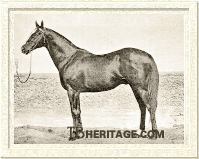
Xaintrailles
| | There wasn't a really good Flageolet colt on the turf again until 1884, when Auguste Lupin took his well-bred two-year-old XAINTRAILLES (1882, out of Lupin's Prix de Diane winner Deliane, by The Flying Dutchman) to England to race in the fall, where he was among the best of his generation. He was third to Paradox and Cora in Newmarket's Dewhurst Stakes, second by a half-length to Melton in the Middle Park Plate (with the English-bred Paradox, who would win the Grand Prix de Paris the next year, third), and two days later won the Prendergast Stakes. |
In France at age three, XAINTRAILLES won the Poule d'Essai des Poulains, le Triennal, and the next month took the Grand Poule des Produits at Longchamp. Rather than run his good colt in the Prix du Jockey Club, Lupin elected to take him to Epsom to run in the Derby. But there were numerous false starts in the huge Derby field that year, and XAINTRAILLES was severely injured in the fracus -- he still finished fourth, but when the extent of his injuries were discovered, it was the end of his career.
XAINTRAILLES inherited the sloping shoulder, neck and good temperament of his sire; he turned out on one leg. Like Flageolet, he was frequently described as "very good looking." He stood at Lupin's Haras Viroflay until 1891, when at the stud's dispersal sale he was purchased by R. Lebaudy for the sales-topping 200,000 francs, but he got comparatively few offspring after 1892, the last year he served at Viroflay. Although he took Dollar's principal place -- and box stall -- at Viroflay, he was not anything like that horse as a sire, despite seeing many of Lupin's really prime broodmares, but Lupin's health was failing (he died in 1895 at age 89), and he did not bring the energy to racing that he had during the golden years with Dollar.
XAINTRAILLES got few high-class runners, but numerous daughters that bred on. Several of his sons, including Cadix (1888, from Almanza, by Dollar) and Le Borda (1890, from Brienne, by Dollar) went to Germany, where they were used as improvement sires on half-bred mares and are seen in Trakehner pedigrees.
XAINTRAILLES' best runner was probably Polygone (1891, from Brienne, and so brother to La Borda); he won Chantilly's Prix Hocquart for Edmond Veil-Picard, who picked up Brienne at the Viroflay dispersal. XAINTRAILLES' son Melchior (1891, from Yorande, by Montargis) won the Prix Eclipse at Maisons-Laffitte. Lahire (1891, out of Fair Trade, by Salvator) took Chantilly's Prix Guiche. His son, Le Bizon (1896, out of Sunny Queen, by Galopin) won some races in England. Among his daughters, Saphirine (1892, out of Cornaline, by Boïard) became an important matron in Italy, producing Sansonetto (1904), a winner of the St. Leger Italiano, and Saturno (1907), who took the Derby Italiano.
CONSIGNE (1883, a sister to COUNT ALFRED), bred by Lefèvre, ran in England as a juvenile, where she won Goodwood's Findon Stakes and the Priory Stakes at Pontefract, and ran a half length behind The Bard in Epsom's Westminster Stakes; at age three she was second to Sakountala in the Poule d'Essai des Pouliches. That year, 1885, was one of the last for Lefèvre, who had made a partial dispersal of his stud the previous year, when a number of prominent studs each picked up a dozen or two youngsters, mares and horses in training for huge sums, and when Flageolet was sold to Germany. In 1888 all of Lefèvre's yearlings were sold to Baron Rothschild, and four years later he liquidated what was left of his livestock and sold his famed Haras du Chamant to A. Ménier.
Several French-bred daughters of Flageolet went abroad. In Argentina, his daughter COURBATURE (1884, from La Coureuse by Stockwell) produced the champion Argentinian colt Orange (1894, by Orbit), a winner of the gran Premio Jockey Club (Argentine Derby) and Gran Premio Nacional, and another daughter, GIBARA (1886, out of Indiana, by Young Monarque) was the dam of Cina Cina (1898, by Orbit), a winner of the Gran Premio Selección (Argentinian Oaks).
In Germany
Flageolet was a more than useful stallion in Germany, getting four classic winners from eight crops, but, as a state stud stallion he was intended primarily to improve riding and cavalry horses in Germany. It does not appear that he himself was put to too many half-bred mares, but most of his sons, usually after proving themselves on the racecourse, were farmed out to the state stud depots as improvement stallions, and a number of them are seen in Trakehner, east Prussian, and other warmblood pedigrees. His German contribution to throughbred bloodlines beyond the first generation is sparse. Flageolet died at Graditz in 1898.
GLÖCKNERIN (1887, from Glocke, by The Palmer), was bred and raced by Graditz, and trained, as were all of the Graditz youngsters of the time, by transplanted Englishman Richard Waugh. Her breeding is uncertain, and the stallion Weltmann (by Chamant) is listed as the second, and therefore preferred sire. She won the Preis der Diana, was a poor third to Nickel and Barde in the Grosses Wäldschens-Rennen at Frankfurt (2400 meters), and won the Deutsches St. Leger.
ÖBERAU (1887, from Gravelotte by Champagne) was a good juvenile winner of the Schwarzwald-Rennen at Baden-Baden.
Another Graditz bred and owned filly in the first German-bred Flageolet crop, FASTNACHT (1887, out of F.F., by Rustic), won, at age three, the Hoppegarten's Hertefeld-Rennen, beating Königslieutenant and Ahnenprobe, was second to GLÖCKNERIN in the Deutsches St. Leger, and took Frankfurt's Alexander-Rennen (2400 meters), beating Micaëa and Bielau. Her sister, FORELLE (1889), was another good one; she took the Preis der Diana, beating Santaella and Wonnetraum. F.F., the dam of these two fillies, bred at Graditz, had won the Ratibor-Rennen and other races before retiring back to Graditz; she was also the dam of Fledermaus (1886, by Flibustier), another good filly tha won the Furstenberg-Rennen. F.F. and her half-sister Walhalla (1876, by Rustic), dam of Flageolet's daughter WAHLSTATT (Deutsches St. Leger) and two good winners by Chamant, were both out of the excellent foundation mare Das Veilchen (1868, by Cavendish), who had won the Preis der Diana, and established a very successful family at Graditz.
|
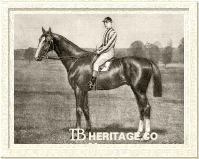
Geheimrath
| |
A crop-mate and near-relative to FORELLE, GEHEIMRATH (1889, out of Geheimniss, the excellent broodmare by Chamant), bred and raced by Graditz, was a handsome horse with good legs and beautiful movement, but a "difficult" temperament, and ultimately a disappointment both on the turf and in the stud. He won his only juvenile race. At age three he won nine of his thirteen races, including the Friedrich Franz-Rennen (walk-over) at Bad Doberan, the Hohenlohe-Oehringen-Rennen at the Hoppegarten, and the Jubiläums-Preis zu Berlin. The next year he was shipped to England to run, where he took the Esher Stakes at Sandown Park, his only win in eight starts. |
After retirement, GEHEIMRATH went to the state stud depots at Stargard and Marienwerder, and later spent a year at Trakehnen, and finally at Braunsberg, where he was shot in 1905. He was used on half-bred mares, and got some daughters that are seen in Trakehner pedigrees. A half-bred son of his, Artig Kind, was used as an improvement stallion in Braunsberg, east Prussia.
Another 1889 Graditz colt by Flageolet, NEBENBUHLER (out of Nachtwandlerin), won the Preis von Thuringen at Gotha at age two.
|
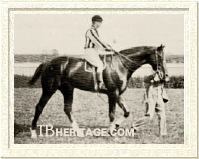
Geier
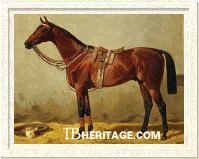
Meistersinger
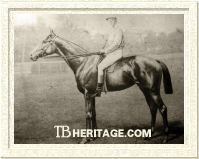
Migräne
| |
GEIER (1890, brother to GEHEIMRATH), also bred and raced by Graditz, won five of his eight starts, including the Union-Rennen and the Grosser Preis von Hannover, and dead-heated with Hardenberg for first in the Deutsches Derby. GEIER was used as an improvement stallion for the state stud, first at Trakehnen, and then in various depots. Another 1890 Graditz colt, AUERHAHN (from Altenburg, by Chamant), won Baden-Baden's Schwarzwald-Rennen as a juvenile.
Another Flageolet son bred at Gradtiz, MEISTERSINGER (1890, out of Mizpah by Savernake), a winner on the flat and then over fences, became an improvement stallion in east Prussia, at Strehlitz. His half-bred daughter, Bulgaria, won prizes as a good example of a superior riding horse, and is seen in Trakhener pedigrees. He had a number of other half-bred offspring that were used in the breeding of Trakehners and East Prussian horses.
WAHLSTATT (1890, from Walhalla, by Rustic, a half-sister to F.F., the dam of FORELLE), a filly bred at Graditz, was second to the German-born, but English-bred Ilse (by Saraband), champion three-year-old in Germany that year, in the Preis der Diana. WAHLSTATT wins included the Deutsches St. Leger and the Grosser Preis von Leipzig at age three.
The 1891 crop included another German classic winning filly, MIGRÄNE (from imported Mocassin, by Wenlock), bred and raced by Carl von Lang-Puchhof. She won three races as a juvenile at the Hoppegarten and Baden-Baden. At age three she took six races, including the Preis der Diana, Breslau's Herzog von Ratibor-Erinnerungs-Rennen, and the Hertefeld-Rennen at the Hoppegarten. At age four she took the Staatspreis First Class at the Hoppegarten. She later produced the winner Minnesold (1901, by Fulmen) for her owner, later used as an improvement stallion on half-bred mares; her daughter M.T. (1898, by Le Sancy) became second dam of Henckel-Rennen winner Taucher (1913, by Malua).
|
One of Flageolet's German sons was GOLDSCHAUM (1891), out of Geheimnis, by Chamant, also dam of GEHEIMRATH, GEIER, and Union-Rennen winner Gastfreund, the latter by Gouverneur. Goldschaum was grandsire of the Mecklenburger Goldschläger I (1909), whose grandson, Goldfisch II (1935) was the modern-day source of extemely successful Hanoverian and Westphalian show jumpers -- Gotthard, Grande and Grannus, all influential sport horse sires, descend from Goldfisch II.
Flageolet's last crop, born in 1894. included the classic winner ARGWOHN (1894, out of Amaranth, by Zealot), who took the Henckel-Rennen for Graditz. His crop-mate, another Graditz-bred colt called LEBEMANN (out of Lorna Doone) placed second to Wokenscieber in the Hamburger Criterium as a juvenile (ARGWOHN was third). At age three LEBEMANN won the Grosser Sachsenpreis at Dresden and placed third in the Hoppegarten's Union-Rennen; the next year he won the Preis von Schlesien at Breslau.
--Patricia Erigero
|
|
|
|

